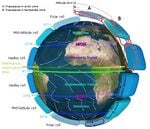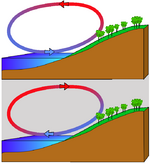No edit summary |
No edit summary |
||
| Line 148: | Line 148: | ||
==Determining the local wind energy levels== | ==Determining the local wind energy levels== | ||
Although it is possible to determine the local wind energy level yourself, global maps are available which instantly provide you a good idea of the wind energy at a specific location and altitude. The advantage of this is that allot of time can be saved (measurements need to be taken over a long period of time) and there is also no risk of miscalculation. Using common sense (ie on a unobstructed location, ...), we can determine a suitable location within an area that is marked on the map as high in wind power. | |||
==Choosing a wind energy harvester depending on the local conditions== | ==Choosing a wind energy harvester depending on the local conditions== | ||
Revision as of 07:19, 28 June 2011





Wind is the flow of gases on a large scale. On Earth, wind consists of the bulk movement of air. Here, it is the result of the uneven heating of the Earth by the sun and the fact that temperatures are invariably trying to reach an equilibrium (heat is always moving to a cooler area). The wind energy is the kinetic energy of the air in motion.
Wind energy levels
The available wind energy or power density varies heavily depending on the location on earth, aswell as the altitude above the soil. There are several classifications, and ways of determining the wind energy. For example, there is the Beaufort scale and the US NREL wind power density classification[1].
Beaufort scale
US NREL wind power density classification
The US NREL wind power density classification separates the wind energy into classes from 1 to 7. Wind speeds for class 1 are 9.8 mph or less on average while the average for a class 7 is 21.1 or even more. Each class has a specific amount of watts per square meter. For that reason, the U.S. Doe has separated wind energy into classes from 1 to 7. The normal For effective power production, class 2 winds (11.5 mph average speed) are frequently required.
Normally, wind speeds increase as you get higher above the Earth.
the available wind energy increases heavily with the altitude. However, on lower altitudes above the soil, VAWT's (vertical axis wind turbines) are more efficient than HAWTs and so you should first try to place your energy harvester as high as possible, but if this doesn't work, use a VAWT (which are at the moment of writing, relatively uncommon).
| General wind classifications | Tropical cyclone classifications (all winds are 10-minute averages) | |||||||
|---|---|---|---|---|---|---|---|---|
| Beaufort scale[2] | 10-minute sustained winds (knots) | General term[3] | N Indian Ocean IMD |
SW Indian Ocean MF |
Australian region South Pacific BoM, BMKG, FMS, MSNZ |
NW Pacific JMA |
NW Pacific JTWC |
NE Pacific & N Atlantic NHC & CPHC |
| 0 | <1 | Calm | Low Pressure Area | Tropical disturbance | Tropical low Tropical Depression |
Tropical depression | Tropical depression | Tropical depression |
| 1 | 1–3 | Light air | ||||||
| 2 | 4–6 | Light breeze | ||||||
| 3 | 7–10 | Gentle breeze | ||||||
| 4 | 11–16 | Moderate breeze | ||||||
| 5 | 17–21 | Fresh breeze | Depression | |||||
| 6 | 22–27 | Strong breeze | ||||||
| 7 | 28–29 | Moderate gale | Deep depression | Tropical depression | ||||
| 30–33 | ||||||||
| 8 | 34–40 | Fresh gale | Cyclonic storm | Moderate tropical storm | Tropical cyclone (1) | Tropical storm | Tropical storm | Tropical storm |
| 9 | 41–47 | Strong gale | ||||||
| 10 | 48–55 | Whole gale | Severe cyclonic storm | Severe tropical storm | Tropical cyclone (2) | Severe tropical storm | ||
| 11 | 56–63 | Storm | ||||||
| 12 | 64–72 | Hurricane | Very severe cyclonic storm | Tropical cyclone | Severe tropical cyclone (3) | Typhoon | Typhoon | Hurricane (1) |
| 13 | 73–85 | Hurricane (2) | ||||||
| 14 | 86–89 | Severe tropical cyclone (4) | Major hurricane (3) | |||||
| 15 | 90–99 | Intense tropical cyclone | ||||||
| 16 | 100–106 | Major hurricane (4) | ||||||
| 17 | 107–114 | Severe tropical cyclone (5) | ||||||
| 115–119 | Very intense tropical cyclone | Super typhoon | ||||||
| >120 | Super cyclonic storm | Major hurricane (5) | ||||||
Determining the local wind energy levels
Although it is possible to determine the local wind energy level yourself, global maps are available which instantly provide you a good idea of the wind energy at a specific location and altitude. The advantage of this is that allot of time can be saved (measurements need to be taken over a long period of time) and there is also no risk of miscalculation. Using common sense (ie on a unobstructed location, ...), we can determine a suitable location within an area that is marked on the map as high in wind power.
Choosing a wind energy harvester depending on the local conditions
Due to this, the normal wind turbine comes with a tower at least 30 feet above obstructions. There are two basic types of towers useful for residential wind power systems (free standing and guyed). Free standing towers are self supporting and are usually heavier which means they take special equipment (cranes) to place them. Guyed towers are supported on a concrete base and anchored by wires for support. They typically are not as heavy and most manufacturer's produce tilt down models which may be easily raised and lowered for maintenance.
The kinetic (moving energy) from the winds is harnessed by a device known as the turbine. This turbine contains airfoils (blades) that capture the energy of the wind and use it to turn the shaft of an alternator (like you have on a car only bigger).
There are 2 basic kinds of blades (drag style and lifting style). We all have seen pictures of old-fashioned windmills with the large flat blades which are a good example of the drag style of airfoil. Lifting style blades are twisted instead of flat and resemble the propellor of a small airplane.
A turbine is classified as to whether it is made to be installed with the rotor in a vertical or horizontal position and whether the wind strikes the blades or the tower first. A vertical turbine typically requires less land for it's installation and is a better option for the more urban areas on the planet. An upwind turbine is created for the wind to impact the airfoils before it does the tower.
These units normally have a tail on the turbine which is required to maintain the unit pointed into the wind. A downwind turbine doesn't need a tail as the wind acting on the blades tends to keep it oriented properly.
These turbine systems would be damaged if they were to be allowed to turn at excessive speeds. Therefore, units should have automatic over-speed governing systems. Some systems use electrical braking systems although some use mechanical type brakes.
The output electricity from the alternator is sent to a controller which conditions it for use in the home. The usage of residential wind power systems requires the home to either remain linked with the utility grid or store electricity in a battery for use when the wind doesn't blow sufficiently.
When the home is tied to the grid, the excess electricity that is created by the residential wind power system can be sold to the utility company to reduce and sometimes even eliminate your electric bill. During times with not enough wind, the home is supplied power from the utility company.
Photo: http://www.residentialwindturbines.org/wind-scheme-grid-tied.gif
Uses
In a appropriate context; the following uses are possible:
- convertion to electricity:
Some great benefits of wind energy are that it's virtually free (once you buy the equipment) and there's no pollution. The disadvantages include the fact it's not a continuing source (the speed varies and many times it is insufficient to generate electricity) and it typically requires about one acre of land.
- transportation:
Wind can also be used as is to propell vehicles such as sail boats and/or hybrids thereof. Other vehicles that make use of the wind included (but are not limited to) sailing ice boats, kite buggies, hot air balloons, kite ski's, ...
The expense of Wind Energy
Small residential wind power turbines can be an attractive alternative, or addition, to those people needing more than 100-200 watts of power for their home, business, or remote facility. Unlike PV's, which remain at basically a similar cost per watt independent of array size, wind generators get cheaper with increasing system size. At the 50 watt size level, for instance, a small residential power turbine would cost about $8.00/watt in comparison to approximately $6.00/watt for a Photovoltaic module.
This is why, all things being equal, Photovoltaic is cheaper for very small loads. As the system size gets larger, however, this "rule-of-thumb" reverses itself.
At 300 watts the turbine costs are down to $2.50/watt, while the PV costs are still at $6.00/watt. For a 1,500 watt wind system the cost is down to $2.00/watt and at 10,000 watts the price of a wind generator (excluding electronics) is down to $1.50/watt.
External links
- http://en.wikipedia.org/wiki/Wind_atlas
- WindTurbines.net: "A Social Network for the Wind Turbine Community" (appears to be a commercially oriented social network).
- http://www.residentialwindturbines.org/ The page of the original article writer
- ↑ Wind power density classes
- ↑ Cite error: Invalid
<ref>tag; no text was provided for refs namedBeaufort - ↑ Coastguard Southern Region (2009). "The Beaufort Wind Scale". Retrieved 2009-03-18.Template:Dead link